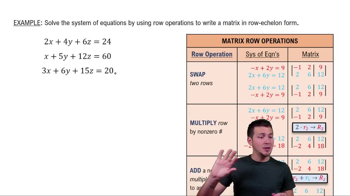Table of contents
- 0. Review of Algebra4h 16m
- 1. Equations & Inequalities3h 18m
- 2. Graphs of Equations43m
- 3. Functions2h 17m
- 4. Polynomial Functions1h 44m
- 5. Rational Functions1h 23m
- 6. Exponential & Logarithmic Functions2h 28m
- 7. Systems of Equations & Matrices4h 6m
- 8. Conic Sections2h 23m
- 9. Sequences, Series, & Induction1h 19m
- 10. Combinatorics & Probability1h 45m
7. Systems of Equations & Matrices
Introduction to Matrices
Problem 65
Textbook Question
Find the partial fraction decomposition of 4x²+5x-9/(x³- 6x-9)
 Verified step by step guidance
Verified step by step guidance1
Identify the type of partial fraction decomposition needed. Since the denominator is a cubic polynomial \(x^3 - 6x - 9\), we need to factor it first.
Attempt to factor the cubic polynomial \(x^3 - 6x - 9\). Look for possible rational roots using the Rational Root Theorem, which suggests testing factors of the constant term (-9) over the leading coefficient (1).
Once a root is found, use polynomial division to divide \(x^3 - 6x - 9\) by \(x - \text{root}\) to find the remaining quadratic factor.
Express the original fraction \(\frac{4x^2 + 5x - 9}{x^3 - 6x - 9}\) as a sum of partial fractions. The form will depend on the factors found: \(\frac{A}{x - \text{root}} + \frac{Bx + C}{\text{quadratic factor}}\).
Solve for the constants \(A\), \(B\), and \(C\) by multiplying through by the common denominator and equating coefficients of like terms on both sides of the equation.
Recommended similar problem, with video answer:
 Verified Solution
Verified SolutionThis video solution was recommended by our tutors as helpful for the problem above
Video duration:
10mPlay a video:
Was this helpful?
Key Concepts
Here are the essential concepts you must grasp in order to answer the question correctly.
Partial Fraction Decomposition
Partial fraction decomposition is a technique used to express a rational function as a sum of simpler fractions. This method is particularly useful for integrating rational functions or simplifying complex algebraic expressions. The goal is to break down a fraction into components that are easier to work with, typically involving linear or irreducible quadratic factors in the denominator.
Recommended video:

Decomposition of Functions
Polynomial Long Division
Polynomial long division is a process used to divide one polynomial by another, similar to numerical long division. When the degree of the numerator is greater than or equal to the degree of the denominator, this step is necessary to simplify the expression before applying partial fraction decomposition. The result of this division can be expressed as a polynomial plus a remainder, which can then be decomposed.
Recommended video:
Guided course

Introduction to Polynomials
Factoring Polynomials
Factoring polynomials involves expressing a polynomial as a product of its simpler polynomial factors. This is crucial in partial fraction decomposition, as the denominators must be factored into linear or irreducible quadratic factors to set up the decomposition correctly. Understanding how to factor polynomials allows for the identification of the appropriate form for the partial fractions.
Recommended video:
Guided course

Introduction to Factoring Polynomials

 4:35m
4:35mWatch next
Master Introduction to Matrices with a bite sized video explanation from Patrick Ford
Start learningRelated Videos
Related Practice











